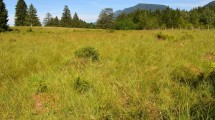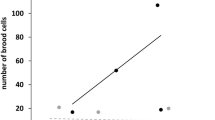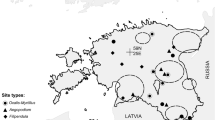Abstract
Purse-web spiders Atypus spp. (Araneae: Atypidae) are the only representatives of the archaic spider infraorder Mygalomorphae in the Central European fauna. These burrow-dwelling spiders are red-listed in all Central European countries. Atypus muralis occurs on relics of continental steppes, Atypus piceus on dry submediterranean grassland and dry herb-rich forest fringes, while Atypus affinis inhabits sparse dwarf dry forests, usually those dominated by oaks. Long-term sustainability of their habitats in the relatively humid Central European climate was maintained by grazing. Since the 1950s, pasturing was terminated across most of Central Europe, which led to immediate overgrowth of pastures by aggressive grasses and woody plants. Grazing was later reinstated in some reserves, but in cases of poorly controlled grazing intensity, footsteps had immediate detrimental effects on the residual populations of purse-web spiders and other invertebrates. Therefore, grazing intensity needs to be regulated, considering its double-edge effects on the biota of xerothermophilic habitats. Nests of European Atypus species have never been found in habitats subject to recent or even regular distribution. Therefore, they may serve as reliable indicators of well preserved xerothermic habitats. Their nests are easy to detect, and the European Atypus spiders can be utilized as model species for monitoring impacts of conservation management. Monitoring population dynamics of Atypus requires establishing permanent study plots of uniform size, documentation of vegetation by phytocenological relevé, counting their density (number of purse-webs found in the plot) and age structure (diameter of purse webs).







Similar content being viewed by others
References
AOPK ČR (2006) The occurence of natural habitats in the Czech Republic [GIS mapping layer, electronic database]. Available at the Nature Conservation Agency of the Czech Republic, Prague
Barton PS, Manning AD, Gibb H, Wood JT, Lindenmayer DB, Cunningham SA (2011) Experimental reduction of native vertebrate grazing and addition of logs benefit beetle diversity at multiple scales. J Appl Ecol 48:943–951
Blight O, Fadda S, Orgeas J, Ponel P, Buisson E, Dutoit T (2011) Using stone cover patches and grazing exclusion to restore ground-active beetle communities in a degraded pseudo-steppe. J Insect Conserv 15:561–572
Bonte D, Maelfait JP, Hoffmann M (2000) The impact of grazing on spider communities in a mesophytic calcareous dune grassland. J Coast Conserv 6:135–144
Braun-Blanquet J (1932) Plant sociology. The study of plant communities. McGraw-Hill Book Company, New York
Bristowe WS (1958) The world of spiders. Collins, London
Broen BV (1965) Einige weitere Bemerkungen über die deutschen Atypus-Arten (Araneae, Atypidae). Zool Anz 175:409–412
Broen BV, Moritz M (1964) Zur Biologie und Verbreitung der deutschen Atypus-Arten (Araneae. Atypidae). Zool Anz 172:147–151
Chytrý M, Kučera T, Kočí M (eds) (2001) Habitat catalogue of the Czech Republic. Agentura ochrany přírody a krajiny ČR, Praha
Cohen A (1962) Présence de l’ Atypus muralis Bertk. dans la Dobroudja. Trav Mus Hist nat “Gr. Antipa” 3:239–252
Dennis P, Young MR, Gordon IJ (1998) Distribution and abundance of small insects and arachnids in relation to structural heterogeneity of grazed, indigenous grasslands. Ecol Entomol 23:253–264
Dennis P, Young MR, Bentley C (2001) The effects of varied grazing management on epigeal spiders, harvestmen and pseudoscorpions of Nardus stricta grassland in upland Scotland. Agric Ecosyst Environ 86:39–57
Ellenberg H (1996) Vegetation Mitteleuropas mit den Alpen in ökologischer, dynamischer und historischer Sicht. Verlag Eugen Ulmer, Stuttgart
Else GR (1975) Aporus femoralis (Van der Linden) (Hym. Pompilidae) in Hampshire and the Isle of Wight and a record of its prey. Entomol Mon Mag 110:82
Eriksson SK, Eriksson B, Ketil P (1997) Fugleedderkoppen, Atypus affinis, er nu genfundet pa Bornholm! Bornh Nat 21:3–13
European Commission (1999) Interpretation manual of European Union habitats—EURI 5, Edition 2. European Commission, Brussels
Farina A (1997) Landscape structure and breeding bird distribution in a sub-Mediterranean agro-ecosystem. Landsc Ecol 12:365–378
Gajdoš P, Svatoň J (2001) Červený (ekosozologický) zoznam pavúkov (Araneae) Slovenska. In: Baláž D, Marhold K, Uhrín P (eds) Červený zoznam rastlín a živočíchov Slovenska. Ochr Prír 20:80–86
Gajdoš P, Svatoň J, Sloboda K (1999) Katalóg pavúkov Slovenska. Institute of Landscape Ecology SAS, Bratislava
Gerlach J, Samways M, Pryke J (2013) Terrestrial invertebrates as bioindicators: an overview of available taxonomic groups. J Insect Conserv 17:831–850
Gertsch WJ (1979) American spiders. Van Nostrand Reinhold Co., New York
Grulich V (2012) Červený seznam cévnatých rostlin České republiky. Available from <http://botany.cz/cs/cerveny-seznam/>. Accessed 7 March 2014
Hajer J (1993) On the spinning apparatus of spiders of the genus Atypus (Araneae, Atypidae). Boll Accad Gioenia Sci Nat 26:165–173
Hansen MDD, Pedersen AA (1997) Fugleedderkoppen Atypus affinis Eichwald, 1830, genfundet i Danmark (Atypus affinis Eichwald, 1830, in Denmark). Flora Fauna 103:1–5
Hautier Y, Niklaus PA, Hector A (2009) Competition for light causes plant biodiversity loss after eutrophication. Science 324:636–638
Hejcman M, Hejcmanová P, Pavlů V, Beneš J (2013) Origin and history of grasslands in Central Europe—a review. Grass Forage Sci 68:345–363
Hiebsch H, Krause R (1976) Zur Verbreitung und Lebensweise von Atypus affinis Eichwald, 1830 in der Sächsischen Schweiz. Faun Abh Staat Mus Tierkund Dresden 6:69–88
Hodge S, Vink CJ (2000) An evaluation of Lycosa hilaris as a bioindicator of organophosphate insecticide contamination. In: Zydenbos SM (ed) Proceedings of the New Zealand plant protection conference. New Zealand Plant Protection Society, Christchurch, pp 226–229
Isaia M, Bona F, Badino G (2006) Influence of landscape diversity and agricultural practices on spider assemblage in Italian vineyards of Langa Astigiana (Northwest Italy). Environ Entomol 35:297–307
Iversen J (1964) Retrogressive vegetational succession in the post-glacial. J Ecol 52:59–70
Jary Z, Ciszek D (2013) Late Pleistocene loess–palaeosol sequences in Poland and western Ukraine. Quat Int 296:37–50
Jonsson LJ (1998) Spiders of the Skaralid Gorge, southernmost Sweden. In: Selgen PA (ed) Proceedings of the 17th European colloquium of arachnology Edinburgh 1997. British Arachnological Society, Edinburgh, pp 273–276
Jung CS, Lee SB, Jung MP, Lee JH, Lee S, Lee SH (2005) Accumulated heavy metal content in wolf spider, Pardosa astrigera (Araneae: Lycosidae), as a bioindicator of exposure. J Asia Pac Entomol 8:185–192
Kati V, Dimopoulos P, Papaioannou H, Poirazidis K (2009) Ecological management of a Mediterranean mountainous reserve (Pindos National Park, Greece) using the bird community as an indicator. J Nat Conserv 17:47–59
Kraus O, Baur H (1974) Die Atypidae der West-Paläarktis. Abh Verh Naturwiss Ver Hamburg 17:85–116
Kropf C, Komposch C, Raspotnig G (1994) Erstnachweise von vier Spinnenarten für Österreich (Arachnida, Araneae). Mitt Abt Zool Landesmus Joanneum 48:69–72
Kruess A, Tscharntke T (2002a) Contrasting responses of plant and insect diversity to variation in grazing intensity. Biol Conserv 106:293–302
Kruess A, Tscharntke T (2002b) Grazing intensity and the diversity of grasshoppers, butterflies, and trap-nesting bees and wasps. Conserv Biol 16:1570–1580
Kučera T (ed.) (2005) Červená kniha biotopů České republiky. Available from <http://www.usbe.cas.cz/cervenakniha>. Accessed 7 March 2014
Laiolo P, Dondero F, Ciliento E, Rolando A (2004) Consequences of pastoral abandonment for the structure and diversity of the alpine avifauna. J Appl Ecol 41:294–304
Lang G (1994) Quartäre Vegetationsgeschichte Europas. Gustav Fischer Verlag, Jena
Lustyk P, Guth J (2012) Methodology of habitat mapping in the Czech Republic. Nature Conservation Agency of the Czech Republic, Prague
Maelfait JP (1996) Spiders as bioindicators. In: van Straalen N, Krivolutsky D (eds) Bioindicator systems for soil pollution. Springer, Berlin, pp 165–178
Maelfait JP, Hendrickx F (1998) Spiders as bio-indicators of anthropogenic stress in natural and semi-natural habitats in Flanders (Belgium): some recent developments. In: Selden PA (ed) Proceedings of the 17th European Colloquium of Arachnology. British Arachnological Society, Burnham Beeches, Bucks, Edinburgh, pp 293–300
Malicky H, Ant H, Aspöck H, De Jong R, Thaler K, Varga Z (1983) Argumente zur Existenz und Chorologie mitteleuropäischer (extramediterran-europäischer) Faunen-Elemente. Entomol Gener 9:101–119
Marc P, Canard A, Ysnel F (1999) Spiders (Araneae) useful for pest limitation and bioindication. Agric Ecosyst Environ 74:229–273
Martinovský JO (1971) Srovnávací fytogeografická studie k problematice středoevropské stepi. Severočeskou přírodou 2:43–107
McFerran DM, Montgomery WI, McAdam JH (1994) The impact of grazing on communities of ground-dwelling spiders (Araneae) in upland vegetation types. Biol Environ 94B:119–126
McIver JD, Parsons GL, Moldenke AR (1992) Litter spider succession after clear-cutting in a western coniferous forest. Can J For Res 22:984–992
Meszner S, Kreutzer S, Fuchs M, Faust D (2013) Late Pleistocene landscape dynamics in Saxony, Germany: paleoenvironmental reconstruction using loess-paleosol sequences. Quat Int 296:94–107
Metera E, Sakowski T, Słoniewski K, Romanowicz B (2010) Grazing as a tool to maintain biodiversity of grassland—a review. Anim Sci Pap Rep 28:315–334
Meusel H (1940) Die Grasheiden Mitteleuropas. Botanisches Archiv 41:357–519
Michajlov KG (1997) Catalogue of the spiders of the territories of the former Soviet Union (Arachnida, Aranei). Zoological Museum of the Moscow State University, Moscow
Miller F (1971) Řád Pavouci—Araneida. In: Daniel M, Černý V (eds) Klíč zvířeny ČSSR IV. ČSAV, Praha, pp 51–306
Moretti M, Conedera M, Duelli P, Edwards PJ (2002) The effects of wildfire on ground-active spiders in deciduous forests on the Swiss southern slope of the Alps. J Appl Ecol 39:321–336
Nentwig W, Blick T, Gloor D, Hänggi A, Kropf C (2013) Spiders of Europe. Available from <http://www.araneae.unibe.ch>. Accessed 7 August 2013
Nilsson SG (1986) Are bird communities in small biotope patches random samples from communities in large patches? Biol Conserv 38:179–204
Paschetta M, La Morgia V, Masante D, Negro M, Rolando A, Isaia M (2013) Grazing history influences biodiversity: a case study on ground-dwelling arachnids (Arachnida: Araneae, Opiliones) in the Natural Park of Alpi Marittime (NW Italy). J Insect Conserv 17:339–356
Pearce JL, Venier LA (2006) The use of ground beetles (Coleoptera: Carabidae) and spiders (Araneae) as bioindicators of sustainable forest management: a review. Ecol Indic 6:780–793
Pedersen AA, Loeschcke V (2001) Conservation genetics of peripheral populations of the mygalomorph spider Atypus affinis (Atypidae) in northern Europe. Mol Ecol 10:1133–1142
Pétillon J, Deruytter D, Decae A, Renault D, Bonte D (2012) Habitat use, but not dispersal limitation, as the mechanism behind the aggregated population structure of the mygalomorph species Atypus affinis. Anim Biol 62:181–192
Platen R, Blick T, Sacher P, Malten A (1998) Rote Liste der Webspinnen (Arachnida: Araneae) (Bearbeitungsstand: 1996, 2. Fassung). Schriftenr Landschaftspfl Natursch 55:268–275
Platnick NI (2013) The world spider catalog, version 14.0. Available from <http://research.amnh.org/entomology/spiders/catalog/index.html>. Accessed 7 August 2013
Řezáč M (2002) Ekologie, rozšíření a karyologie druhů rodu Atypus (Araneae, Atypidae) v Čechách. Msc. Thesis, Charles University in Prague
Řezáč M (2003a) Upozorňují sklípkánci na pravěké osídlení? Vesmír 82:670
Řezáč M (2003b) Spiders (Araneae) of the thermophilous oak wood in the Kokořínsko protected landscape area. Boh Cent 26:237–243
Řezáč M (2009) Distribution and conservation of the purse-web spiders (Araneae: Atypus spp.) in the Czech Republic. Příroda Praha 28:3–43
Řezáč M, Kubcová L (2002) Rozšíření pavouků (Araneae) čeledí Atypidae, Eresidae a Titanoecidae v České republice. Klapalekiana 38:37–61
Řezáč M, Král J, Musilová J, Pekár S (2006) Unusual karyotype diversity in the European spiders of the genus Atypus (Araneae: Atypidae). Hereditas 143:123–129
Řezáč M, Řezáčová V, Pekár S (2007) The distribution of purse-web Atypus spiders (Araneae: Mygalomorphae) in central Europe is constrained by microclimatic continentality and soil compactness. J Biogeogr 34:1016–1027
Roberts MJ (1996) Spiders of Britain and northern Europe. Collins, London
Rolando A, Dondero F, Ciliento E, Laiolo P (2006) Pastoral practices and bird communities in Gran Paradiso National Park: management implications in the Alps. J Mt Ecol 8:21–26
Šálek M (2012) Spontaneous succession on opencast mining sites: implications for bird biodiversity. J Appl Ecol 49:1417–1425
Schwendinger PJ (1990) A synopsis of the genus Atypus (Araneae, Atypidae). Zool Scr 19:353–366
Staręga W, Błaszak C, Rafalski J (2002) Arachnida pajęczaki. In: Głowaciński Z (ed) Czerwona lista zwierząt ginących i zagrożonych w Polsce. Polska akademia nauk. Institut ochrony przyrody, Kraków, pp 133–138
Stein B, Bogon K, Kraus O (1992) Tapezierspinnen in N-Hessen, S–Niedersachsen und E–Westfalen (Arachnida, Araneae, Atypidae). Verh Naturwiss Ver Hamburg 33:229–237
Szinetár C, Lajos L (2000) A Szársomlyó pókfaunisztikai (Araneae) kutatásának eredményei (Faunistical results of the investigation of the spider fauna (Araneae) of Szársomlyó Hill, Villány Hills, South-Hungary). Dunántúli Dolg Term Tud Sorozat 10:127–138
Szinetár C, Samu F (2012) Intensive grazing opens spider assemblage to invasion by disturbance-tolerant species. J Arachnol 40:59–70
Török P, Matus G, Papp M, Tóthmérész B (2008) Secondary succession in overgrazed Pannonian sandy grasslands. Preslia 80:73–85
van Noordwijk CGE, Flierman DE, Remke E, WallisDeVries MF, Berg MP (2012) Impact of grazing management on hibernating caterpillars of the butterfly Melitaea cinxia in calcareous grasslands. J Insect Conserv 16:909–920
Vera SWM (2000) Grazing ecology and forest history. CABI publishing, Waltingford
Waitzbauer W, Lindinger T, Jank W (1994) Zur Verbreitung der Tapezierspinnen (Atypidae) im östlichen Niederösterreich (Distribution of purse-web spiders (Atypidae) in eastern Lower Austria). Verh Zool-Bot Ges Österreich 131:153–162
Wiehle H (1953) Spinnentiere oder arachnoidea (Araneae) IX: orthognatha, cribellatae, haplogynae, entelegynae. In: Dahl F (ed) Tierwelt deutschlands, angrenzenden Meeresteile, 42. Veb Gustav Fischer Verlag, Jena
Wiśniowski B (2009) Spider-hunting wasps (Hymenoptera: Pompilidae) of Poland. Ojców National Park, Ojców
Acknowledgments
We thank Pavel Mudra, Milan Chytrý and Jørgen Lissner for the provision of photographs, Lucie Kratochvílová, Zdeněk Kučera and Jan Zárybnický from the Nature Conservation Agency of the Czech Republic for the data about habitats in the Czech Republic, Tomáš Klouček for help with the distribution maps, and Marie Luise Schmidt for corrections of the manuscript. This study was supported by the Ministry of Agriculture of the Czech Republic (Grant MZe RO0414).
Author information
Authors and Affiliations
Corresponding author
Rights and permissions
About this article
Cite this article
Řezáč, M., Heneberg, P. Conservation status of the only representative of infraorder Mygalomorphae (Araneae) in cultivated regions of Central Europe. J Insect Conserv 18, 523–537 (2014). https://doi.org/10.1007/s10841-014-9668-y
Received:
Accepted:
Published:
Issue Date:
DOI: https://doi.org/10.1007/s10841-014-9668-y




